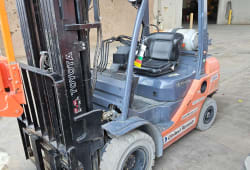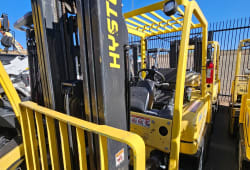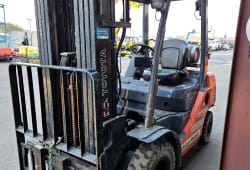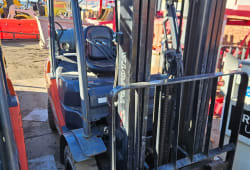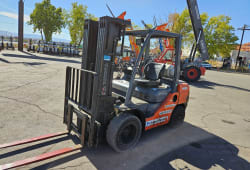Maximizing Forklift Efficiency: The Cost-benefit of Side Shifter Attachments
12 Min read
)
January 4, 2024
The cost-benefit analysis of forklift attachments demonstrates that investing in the right attachments can significantly improve efficiency, reduce downtime, enhance safety, and increase productivity. The return on investment can be substantial, considering the long-term benefits they offer, such as reduced labor costs, improved product handling, and increased overall operational effectiveness.
Side Shifters:
:format(webp))
Manual side shifters provide a straightforward and economical solution, relying on manual adjustments for lateral load movement. In contrast, hydraulic side shifters leverage hydraulic systems, ensuring seamless and precise load handling, reducing operator fatigue, and enhancing efficiency.
Determining the wisest investment involves assessing whether the expense is justifiable or if it unduly strains your budget.
Tips for choosing the right side shifter depend on forklifts and load types:
Forklift Compatibility: Consider compatibility with the forklift model. Some forklifts may require specific attachments or hydraulic systems for optimal integration.
Load Variation: For varied loads, hydraulic side shifters provide precision and ease in adjusting loads of different sizes or shapes.
Operational Requirements: Assess the operational needs-manual side shifters suit simpler tasks, while hydraulic options excel in heavy-duty or frequent shifting operations.
Budget and Maintenance: Evaluate cost-effectiveness and maintenance requirements. Manual shifters are often more affordable and have lower maintenance needs compared to hydraulic systems.
Operator Comfort: Hydraulic side shifters reduce operator strain and offer precise control, ideal for tasks demanding accuracy or prolonged usage.
1. Clamps:
:format(webp))
1.1: Palletless Carton Clamps
Applications:
Food and beverage industry: No need to sweat to do that manually, or reach the top shelf for handling and stacking of cardboard boxes filled with products like canned goods, bottles, or plastic containers.
Paper and packaging industry: Moving and stacking reams of paper, corrugated cardboard sheets, or finished packaging materials.
Retail and wholesale distribution: Loading and unloading cartons onto pallets or conveyor belts in warehouses and distribution centers.
Automotive industry:
Imagine how heavy it would be to handle and transport auto parts and components in cardboard boxes.
1.2 Drum Clamps
Applications:
Chemical and petrochemical industry: Lifting and moving drums filled with hazardous or flammable liquids, chemicals, or solvents.
Food and beverage industry: Handling and stacking drums containing edible oils, syrups, or other liquids.
Manufacturing industry: Transporting drums of raw materials, paints, or chemicals in production facilities.
Waste management industry: Moving and emptying drums containing hazardous or toxic waste materials.
1.3 Sheet Metal Clamps
Applications:
Metal fabrication industry:
Lifting and transporting large sheets of metal, plates, or coils in steel mills and fabrication shops.
The following work is done in various types of industries ranging from construction to shipbuilding industry.
Construction industry: Moving metal sheets for roofing, cladding, or HVAC installations.
Automotive industry: Handling and stacking metal sheets for vehicle production.
Shipbuilding industry: Lifting and positioning metal sheets for shipbuilding and repair.
2. Rotators:
:format(webp)) Forget clunky, limited rotations of yesterday's forklift attachments! Today's rotators are packed with cutting-edge features that take load handling to a whole new level of precision and efficiency. Let's dive into the world of continuous rotation and programmable rotation angles, two game-changers for specialized tasks like barrel dumping and container emptying.
Forget clunky, limited rotations of yesterday's forklift attachments! Today's rotators are packed with cutting-edge features that take load handling to a whole new level of precision and efficiency. Let's dive into the world of continuous rotation and programmable rotation angles, two game-changers for specialized tasks like barrel dumping and container emptying.
Continuous Rotation: A Dance of Infinite Possibilities
Manual side shifters offer cost-effective, manual lateral load adjustments, while hydraulic counterparts ensure seamless, precise handling via hydraulic systems, enhancing efficiency. Assessing investment worthiness considers budget impact and operational necessity.
Programmable Rotation Angles: Precision Personified
Forget wrestling with levers and estimating angles. Programmable rotation angles let you dial in the exact degree of rotation you need, guaranteeing pinpoint accuracy for even the most demanding tasks.
Picture this: a bustling packaging line. You need to carefully tip a container of ingredients into a hopper at a specific angle for optimal mixing. No problem! Program the rotator to tilt to the perfect angle, and let the machine handle the heavy lifting (or, well, tilting!).
Specialized Tasks, Mastered:
These advanced features aren't just fancy bells and whistles - they're game-changers for specific industries. Here's how they revolutionize:
Barrel Dumping: Continuous rotation eliminates spillage and ensures controlled unloading, while programmable angles allow for precise barrel positioning onto pallets or conveyor belts.
Container Emptying: Programmed rotations mean accurate tipping angles for efficient material transfer, leading to faster operations and less product waste.
Tank Cleaning: Gentle, continuous rotation combined with targeted angles ensures thorough cleaning, especially for awkwardly shaped tanks.
Precision Placement: From delicate machinery components to large industrial parts, programmable rotation angles guarantee accurate positioning, saving time and reducing the risk of damage.
3. Push/Pull Attachments:
:format(webp))
Efficient warehouse operations rely on the right forklift attachments. Push plates excel in linear movement and gentle handling for narrow spaces and fragile goods. Push blades offer better maneuverability and handle mixed operations and heavier loads with improved slip-sheet grip. Both options cater to specific needs, enhancing overall warehouse efficiency.
3.1 Push-Pull Combinations:
Design: A hybrid, combining both push plates and blades, offering both pushing and pulling functionalities.
Benefits: Ultimate versatility, handling both pallets and slip-sheets, efficient in confined spaces, suitable for multiple tasks.
Ideal for: Warehouses with diverse load types, frequent pallet/slip-sheet switching, maximizing space utilization.
Matchmaking in the Warehouse:
Now, let's pair these attachments with the perfect warehouse scenarios:
Narrow aisles: Push plates win for their compact design and minimal load engagement, ensuring smooth navigation in tight spaces.
Large open areas: Push blades unleash their potential here, offering maneuvering flexibility and efficient handling of heavier loads.
Multi-functional operations: Push-pull combinations reign supreme, seamlessly switching between pallets and slip sheets, maximizing resource utilization.
Beyond the Design:
Remember, choosing the right attachment goes beyond just the design. Consider factors like
Forklift compatibility: Ensure the attachment matches your forklift's capabilities and hydraulic system.
Load weight and type: Opt for stronger models for heavier loads and push-pull functionality for diverse requirements.
Operator skill level: Push plates are simpler to use, while push blades and combinations might require more training.
4. Carpet Poles:
:format(webp))
Vertical vs. Horizontal Carpet Poles: Roll Size and Material Suitability
Vertical Carpet Poles:
Ideal for taller roll stacking in limited spaces, maximizing warehouse height.
Suited for larger, heavier rolls due to their vertical orientation, distributing weight more evenly.
Efficient for carpet rolls with varying diameters, offering flexibility in handling different sizes.
Horizontal Carpet Poles:
Suitable for shorter spaces where vertical stacking isn't feasible.
Best for shorter or medium-sized rolls, ensuring stability during transportation.
Preferable for delicate or sensitive materials, as they reduce stress on the carpet's inner layers.
Safe Carpet Handling Techniques
Inspecting Rolls: Before handling, inspect rolls for damages or irregularities to prevent mishaps during transportation or stacking.
Balanced Lifting: Use appropriate lifting equipment, distributing weight evenly along the carpet pole for stability.
Secure Attachment: Ensure the carpet is securely attached to the pole using straps or attachments to prevent slipping.
Slow Maneuvering: Move slowly and steadily, especially when navigating corners or narrow spaces, to avoid sudden shifts or accidents.
Proper Stacking: Stack rolls on stable, level surfaces, avoiding overloading or uneven stacking to prevent accidents and damages.
Team Communication: Employ effective communication among team members during handling to ensure coordination and safety.
Protective Gear: Use appropriate personal protective equipment (PPE) to prevent injuries, especially when handling heavy or bulky rolls.
Drum Handlers:
In the industrial world, drums aren't just musical instruments - they're vital vessels for a symphony of materials, from chemicals to food products. When it comes to handling these hefty players, choosing the right drum handler for your forklift is crucial for a smooth performance. So, let's explore the stage lights illuminating single-drum vs. multi-drum handlers and their starring roles in weight capacity and safety.
Drum Solo or Ensemble?
Single-Drum Handlers: These are the one-person shows of the drum handling world, efficiently lifting and transporting a single drum at a time.
Multi-Drum Handlers: Picture a drumline in sync - these bad boys can handle two or more drums simultaneously, ideal for high-volume operations.
Lifting the Curtain on Weight Considerations:
Single-Drum Handlers: Like a well-trained soloist, they excel with lighter to medium-weight drums, typically ranging from 500 to 2000 pounds.
Multi-Drum Handlers: Think of them as the musclemen of the stage, capable of handling heavier ensembles, often lifting up to 4000 pounds or more per drum, depending on the model.
Safety Features Applause:
But a flawless performance isn't just about brawn - it's about safety too. Here's how these handlers ensure the show goes on without a hitch:
Drum Grips: Like a firm handshake, these secure the drum in place, preventing slips and accidents. Opt for hydraulic or mechanical options depending on your needs.
Tilt Mechanisms: Imagine adjusting the spotlight - tilt mechanisms allow you to angle the drum for easy loading, unloading, and pouring, reducing operator strain and risk.
So, who takes center stage in your industrial orchestra?
Single-Drum Handlers: Perfect for solo acts, ideal for smaller facilities, handling fragile drums, or occasional drum movement.
Multi-Drum Handlers: Rock out with high-volume operations, efficient batch handling, heavy drums, or space optimization needs.
Beyond the Spotlight:
Remember, choosing the right drum handler is a duet between your needs and capabilities. Consider factors like:
Forklift compatibility: Ensure the handler's capacity and mounting system match your forklift.
Drum size and weight: Choose a handler that can safely handle your specific drum types and weights.
Frequency of use: Opt for a robust model for high-volume operations and consider ease of maintenance.
Cost-Benefit Analysis of Forklift Attachments:
1. Fork Extensions:
- Cost Range: $300 - $1,500
- ROI: Improved productivity and reduced product damage due to better load handling.
2. Side Shifters:
- Cost Range: $500 - $2,000
- ROI: Increased efficiency and safety, leading to improved productivity and reduced downtime.
3. Clamps:
- Cost Range: $1,000 - $5,000
- ROI: Increased productivity and improved safety, resulting in reduced labor costs and improved efficiency.
4. Rotators:
- Cost Range: $2,000 - $10,000
- ROI: Improved efficiency and reduced product damage, leading to increased productivity and reduced labor costs.
5. Push/Pull Attachments:
- Cost Range: $500 - $2,000
- ROI: Improved efficiency and reduced labor requirements, resulting in increased productivity and cost savings.
6. Carpet Poles:
- Cost Range: $200 - $500
- ROI: Increased productivity and improved safety, leading to reduced product damage and improved efficiency.
7. Drum Handlers:
- Cost Range: $1,000 - $3,000
- ROI: Improved safety and increased productivity, resulting in reduced downtime and improved efficiency.
8. Jib Booms:
- Cost Range: $3,000 - $10,000
- ROI: Increased versatility and improved productivity, leading to reduced downtime and increased efficiency.
9. Sweeper Brooms:
- Cost Range: $500 - $1,500
- ROI: Improved efficiency and reduced labor requirements, resulting in a cleaner and safer working environment.
10. Snow Plows:
- Cost Range: $1,000 - $3,000
- ROI: Reduced downtime and improved safety during winter conditions, leading to increased productivity and reduced operational disruptions.
The Final Encore:
By understanding the differences between single-drum and multi-drum handlers, considering weight capacity and safety features, and carefully matching them to your industrial score, you can ensure a safe, efficient, and harmonious performance in your drum-handling symphony. So, raise the curtain on operational excellence and let the right handler take center stage!

Mike Kennedy is Boom & Bucket's Marketplace Operations Manager, where he leads shipping, warranties, and post-sale operations to create a seamless buyer experience. As one of the company's earliest team members, Mike helped build the foundation of Boom & Bucket's operations and guided its growth through acquisition by RB Global. He is passionate about scaling marketplaces, solving operational challenges, and improving efficiency to deliver industry-leading results.

